ASTR 1210 (O'Connell) Study Guide 20
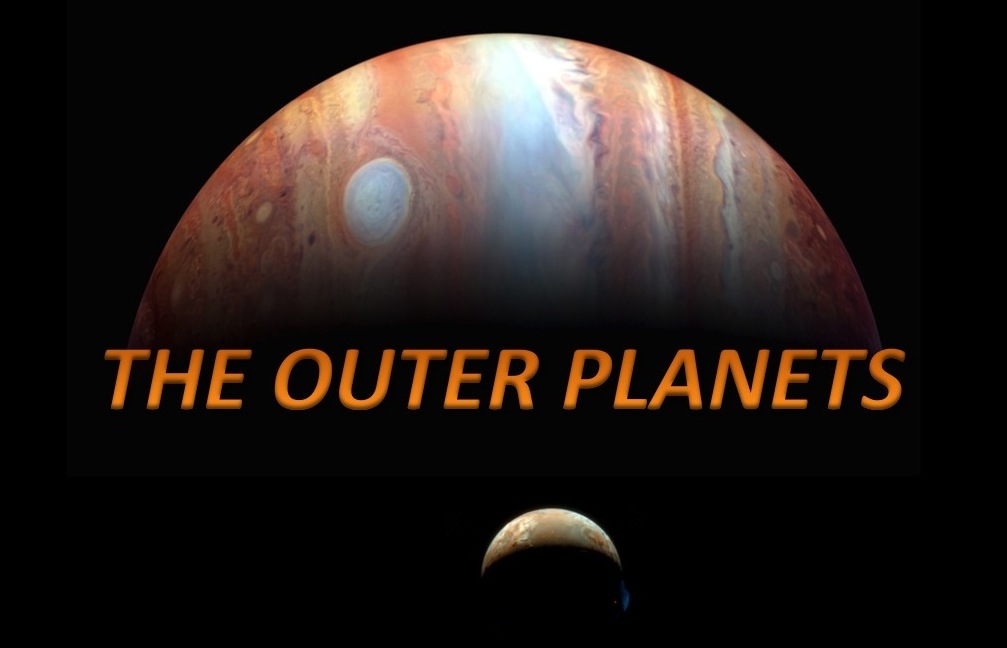
Jupiter with erupting Io in foreground
(New Horizons Mission image)
A. History of Exploration Beyond Mars
-
Prehistory: Jupiter, Saturn known
1610-1700: Galileo discovers four large
satellites in orbit around Jupiter. Later in the 17th century
Huygens and Cassini discover
the rings
and several large satellites of Saturn and the giamt "Red Spot" on
Jupiter.
1704:
Edmond Halley determines the orbit of the
eponymous comet and discovers
that it travels in a huge, highly elongated orbit.
-
Halley's work dramatically expands the horizon of the Solar
System. The comet's aphelion (greatest distance from the Sun) is
35 AU's, over three times farther than Saturn, at 9.5 AU's. But
remember that in 1704, neither Uranus nor Neptune had been discovered.
So, the long orbit of Halley's Comet plunged it into a completely
mysterious outer realm that offered the promise of many discoveries
yet to come.
-
Although the search for Pluto followed the methods established for
Neptune, based on apparent abnormalities in the orbits of Neptune and
Uranus, it quickly became clear that its discovery
was accidental: Pluto is too small to have affected the other
planets' motion significantly, nor were the claimed distortions in
their orbits accurate.
Pluto also broke the pattern established by the four other planets
beyond Mars (Jupiter, Saturn, Uranus, and Neptune): it was not
a gas giant planet. Instead, it was so small it could not be
resolved by telescopes of the time and showed indications of
having a rocky surface.

Flyby orbits of Voyager Missions to outer planets
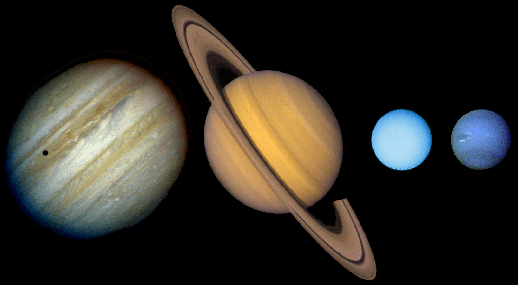
Spacecraft images of the four Jovian planets (from left: Jupiter,
Saturn, Uranus, Neptune),
scaled to their correct relative sizes (but not
distances from the Sun).
B. Jovian Planets: Properties
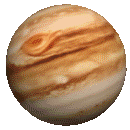 The four Jovian planets share gross properties. Pluto is entirely
different (see below).
Distant from Sun: 5-30 AU. (Pluto is at 39 AU.)
Large: The Jovians are 4-11 times larger in diameter than Earth.
Jupiter's volume is 1300 times the Earth's. Masses are 15(U)-318(J)
times Earth's. Jupiter contains twice as much mass as all other
planets combined. An animated timelapse image of Jupiter's rotation
and surface features is shown at the right. Click on the image for
a more
recent, high
resolution video.
The four Jovian planets share gross properties. Pluto is entirely
different (see below).
Distant from Sun: 5-30 AU. (Pluto is at 39 AU.)
Large: The Jovians are 4-11 times larger in diameter than Earth.
Jupiter's volume is 1300 times the Earth's. Masses are 15(U)-318(J)
times Earth's. Jupiter contains twice as much mass as all other
planets combined. An animated timelapse image of Jupiter's rotation
and surface features is shown at the right. Click on the image for
a more
recent, high
resolution video.
-
Jupiter is midway between terrestrial planets and stars on a
power of ten mass scale. Objects only 13 times more massive are
considered to be small stars, not planets.
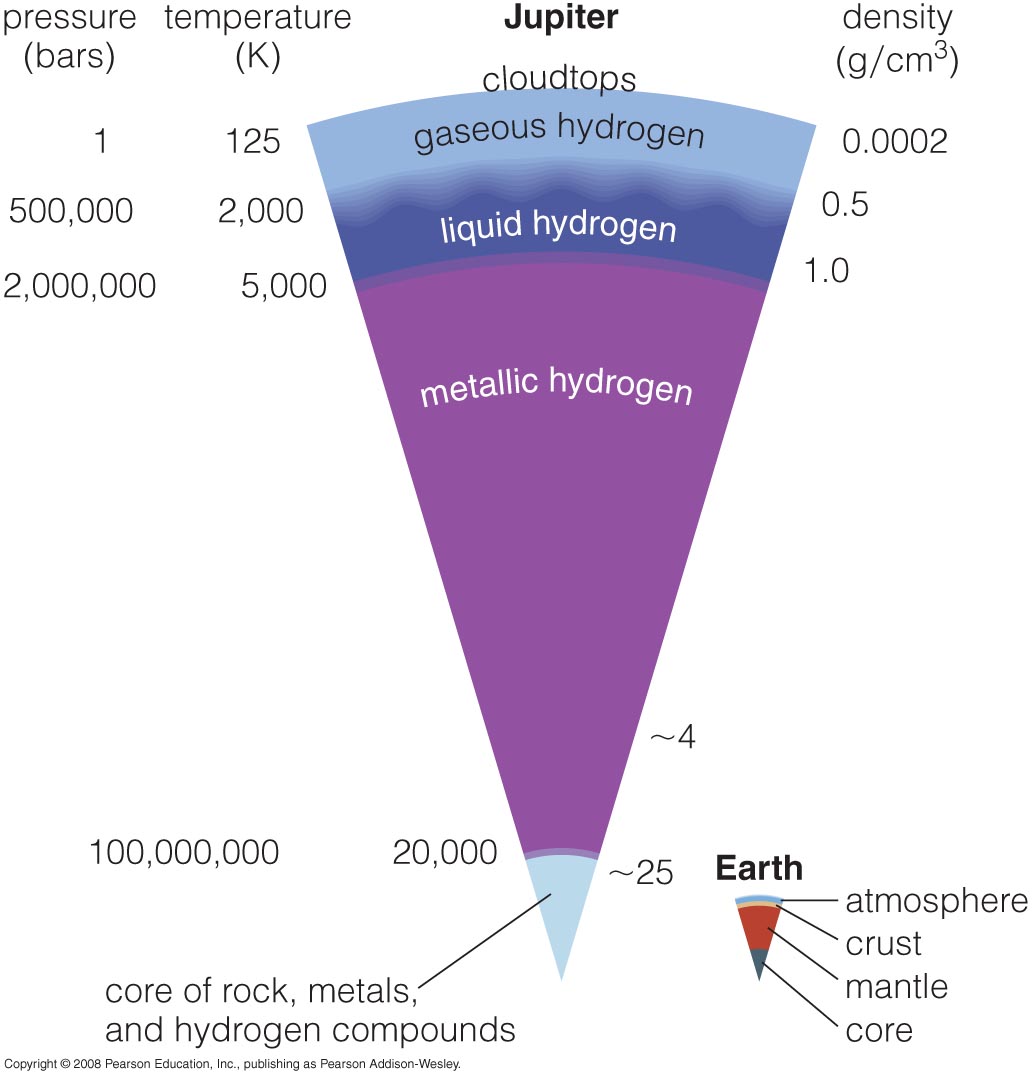
Structures
- Their low mean densities (~ 1 gram/cc) imply that Jupiter and Saturn are mainly composed of H and He, with only small rocky cores, perhaps Earth-size. That is a product of their formation out of the cool regions of the solar nebula, which were dominated by icy (H-rich) solids. Uranus and Neptune have larger fractional complements of heavy elements than Jupiter and Saturn.
- Internal structures are entirely different from terrestrial planets because of their predominant hydrogen composition. Click on the Jupiter cross-sectional drawing at right for an enlarged version. The high internal pressures in Jupiter and Saturn convert hydrogen gas to liquid or "metallic" form in their interiors. The lower-pressure interiors of Uranus and Neptune contain mantles composed of ammonia, methane, and water. Unlike Terrestrial planets, the Jovians have no solid surfaces. They are "gas giants".

Visible Surfaces
- The visible surfaces of the Jovians are cloud layers, about 150 miles deep. The clouds consist of 3 main types of ice crystals: ammonia, ammonium hydrosulfide, and water. Colors are from trace compounds. Thin, white clouds on Neptune are methane crystals, which freeze out at the lower atmospheric temperature there.
- "Spots": The most famous is Jupiter's Red Spot (the large oval in the image at right: 22,000 mi long ~ 3x Earth's diameter). It is a long-lived cyclonic storm. The transient "Great Dark Spot" on Neptune was a similar feature, and many smaller spots or ovals, mostly transient and ranging from dark red to white in color, are visible in the Jovian atmospheres (most conspicuous on Jupiter; 8 are present in the image at the right).
- Atmospheric banding is caused by powerful lateral
windstreams fed
by rising/falling convection currents. Winds reach
300-600 mph on Jupiter and Saturn and up to 1300 mph on Neptune. See
the enhanced pseudocolor image of Saturn's atmospheric banding below
right.
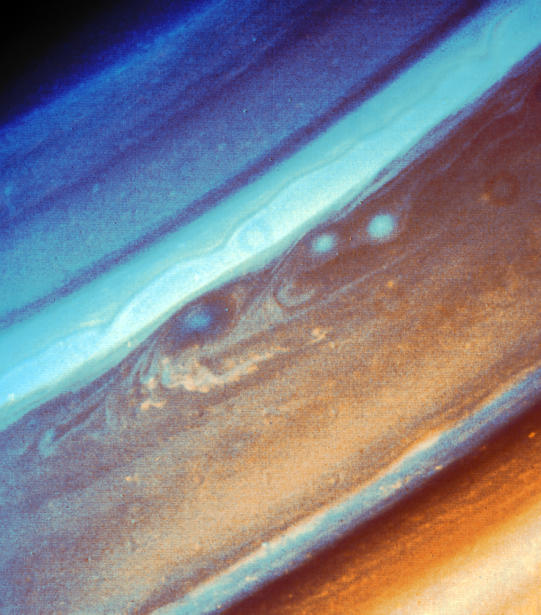
- The Juno
spacecraft, skimming in an elliptical orbit to within 2600 miles of
Jupiter's cloud layers, is now
returning amazingly detailed
images of the atmosphere.
-
Here is a beautiful recent
Juno image of Jupiter's Red Spot with Io in the foreground, casting a
shadow.
 Videos of Jupiter atmosphere:
Videos of Jupiter atmosphere:
- Voyager 1 "Blue Movie" (time lapse of approach to planet)
- Voyager 1 Red Spot Movie
- Cassini Full Surface Movie
- Videos from Juno mission
Special Probes of Jupiter
- Comet Shoemaker-Levy-9: was captured by Jupiter and hit the planet in 1994. The impact acted as a "natural" atmospheric probe; infalling fragments produced multiple enormous, concentrated energy releases in the atmosphere. The explosions were bright and the scars long-lived.
- The Galileo spacecraft probe was sent into Jupiter's atmosphere in 1995 and returned pressure, temperature, and composition profiles to a depth of almost 100 miles before it was crushed by the pressure.
Magnetospheres
-
Strong magnetic fields are generated by motions in the liquid metallic
hydrogen interiors of Jupiter & Saturn. Because the magnetic fields
trap energetic protons and electrons, these
produce powerful radiation
belts, up to 100x stronger than those of Earth.
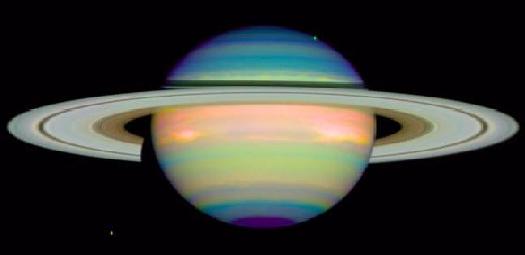
Pseudo-color infrared image of Saturn
C. Ring Systems
 Saturn has the brightest rings, but rings are present around all 4
Jovians
Saturn has the brightest rings, but rings are present around all 4
Jovians
- The rings are not solid: the inner rings revolve faster than the outer ones, as expected for objects in Keplerian gravitational orbits
- The rings are huge in width but by comparison are remarkably thin, mostly less than 1 km (3300 feet) thick. They have an aspect ratio of about 300,000:1. This is over 110 times thinner than standard printer paper. Here is an article on the ring geometry by Phil Plait.
- The rings are composed of billions of ice-coated particles (typically about 10 cm in size). Different particle sizes and coatings produce some of the structure visible in the rings.
- Origin: the rings are primarily debris from
tidally or collisionally fragmented satellites
-
The rings lie inside the planet's "Roche Limit". Closer
than this distance from the planet's core, gravity tides would
pull apart a large body, such as a satellite.
- The rings have a complex structure (at right), consisting of numerous gaps and ringlets. The biggest gaps are "resonance" effects produced by the cyclical gravitational tug of the satellites outside the ring. The ringlets may be produced by the self-gravity of the material in the rings.
 A video of Saturn's rings from the Cassini mission
A video of Saturn's rings from the Cassini mission

Spacecraft images of the four Galilean satellites of
Jupiter, shown to scale
(Io, Europa, Ganymede, and Callisto).
D. The Jovian Planet Satellites
In many ways, the satellites of the Jovian planets are more interesting than the planets themselves. The four largest satellites of Jupiter (the "Galilean satellites") were discovered by Galileo and were the first additions to the planetary inventory of the Solar System in recorded history. Galileo saw them only as points of light, and good information on their surfaces was not obtained until the spacecraft flyby missions of the 1970's and 80's. The composite picture above shows spacecraft images of the four Galilean satellites (scaled to the correct relative sizes). It illustrates the outstanding feature of these four satellites: they are amazingly different from one another. Each is a unique world in its own right. They are typical of all Jovian satellites in that they are diverse, and they often have had violent histories. Here are some of the other characteristics of the Jovian satellites:-
The satellite complement for a given planet is large: 14-79
- Two are larger than Mercury. See this comparison of satellites and planets.
- The large moons formed at the same time as their parent planet
- Because of their large ice content, their surfaces are more plastic than those of the terrestrial planets; some show extensive evidence of melting and resurfacing.
- Most of these are rocky or icy planetesimals/asteroids, which were gravitationally captured by a planet over time.
 Click here for a Java animation of orbits of
the satellites of each planet
Click here for a Java animation of orbits of
the satellites of each planet
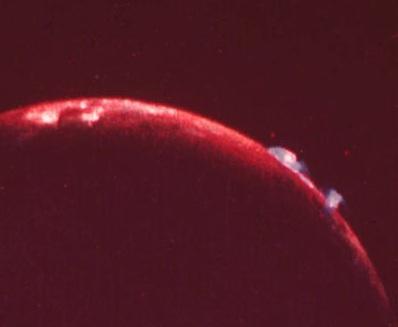 Important examples of satellites: (click on the names for additional
illustrations)
Important examples of satellites: (click on the names for additional
illustrations)
- Io (J): Io is the innermost of the four Galilean satellites of Jupiter. It suffers continual volcanic eruptions caused by heating from tidal flexing in Jupiter's gravitational field. Io is much more active today than even the Earth. There are presently over 400 active volcanoes on Io. Its huge volcanic plumes at the time of their discovery by Voyager 1 in 1979 are shown at the right.
- Europa (J): The second
Galilean satellite is completely ice-coated and
extraordinarily smooth (i.e. has a small range of elevation).
Few craters, indicating a young surface. Most scientists believe the
ice shell covers an underlying
ocean, kept warm by tidal flexing (less severe than for Io).
Long, dark lines on the surface may be places where the shell has
cracked, allowing filling by younger ice. In 2013, NASA announced
the detection
of water
vapor plumes jetting off of Europa's surface (like the similar
features found earlier on Enceladus). Because of the presence of
water, there is much speculation about a possible biosphere
on Europa (see Study Guide 23).
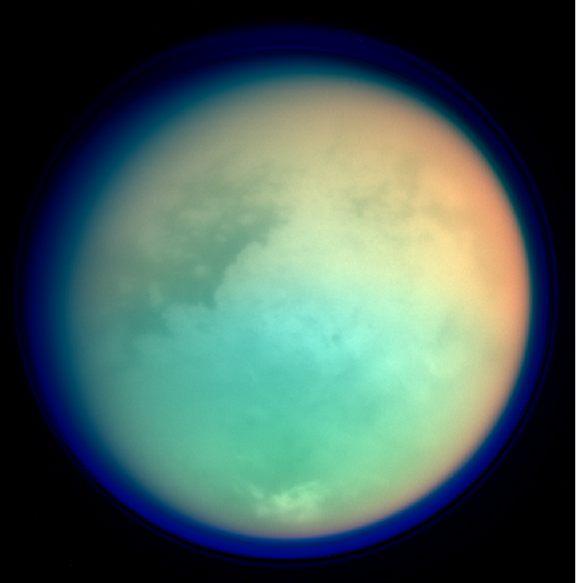
- Titan (S):
Saturn's largest moon has a
thick atmosphere(!), visible as a
blue haze in the infrared image at the right. It is
mostly nitrogen with a small amount of methane. Titan is the
only object in the Solar System other than Earth to have a
predominantly nitrogen atmosphere. The atmosphere can be retained,
despite Titan's small mass, because of its low temperature at Saturn's
distance from the Sun.
-
Titan was the main target of the
European
Cassini-Huygens Mission. While the primary spacecraft stayed in
orbit around Saturn, the Huygens probe was detached and successfully
landed on Titan's surface in January 2005, relaying data during its
descent and for a short period on the ground.
Solar UV light interacting with methane has produced a rich mixture of
hydrocarbon
clouds and obscuring haze. There is probably hydrocarbon rain
on Titan.
Click
here for an atmospheric profile.
Recent radar data from the orbiting Cassini spacecraft shows that
there are large lakes on
Titan, probably of methane or ethane. These are in liquid form
because of the very low surface temperature. Titan is the only solar
system object other than Earth to have open bodies of liquid on its
surface.
In company with Europa and Enceladus (see below), Titan is now regarded
as a possible site of a biosphere --- but with lifeforms based on
utilizing methane rather than carbon dioxide.
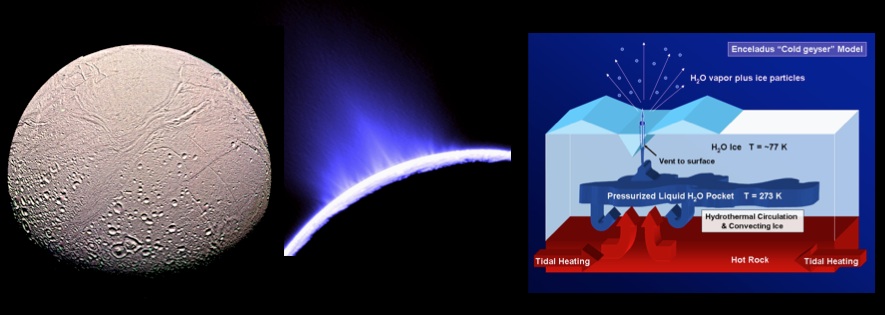
Left: Enceladus; Center: water vapor plume from Enceladus; Right: possible internal structure of Enceladus
- Enceladus(S): Although
only a small satellite, Enceladus became a focus of astronomer
interest when it was unexpectedly discovered by the Cassini orbiter to
possess huge water/ice geysers jetting into space from its
surface. The plumes contain water vapor, complex hydrocarbons, and
sodium salts. The plumes are thought to originate from warm liquid
water reservoirs beneath the surface which are heated by tidal
flexing; jets escape through deep vents. See the picture above. The
outflow from Enceladus feeds material into Saturn's "E ring."
-
In April 2014, scientists announced that gravity measurements deduced
from tiny accelerations of the Cassini spacecraft in the vicinity of
Enceladus confirm the presence of a liquid ocean with a volume
comparable to Lake Superior lying under its south pole.
- Miranda (U): has a remarkable patchwork surface, probably from a shattering collision & reassembly or possibly surface scars from internal convection
- Triton (N): the largest satellite of Neptune is a captured KBO. (It has a "retrograde" orbit -- it orbits in the opposite direction to Neptune's spin -- implying it did not form with Neptune but was gravitationally captured later.) Triton has a young, nitrogen-rich surface with diverse structural features caused by ice melting, shifting, and re-freezing. During Voyager 2's brief passage, it featured several geysers or "cryovolcanos" of nitrogen, methane, ice, and dust jetting out of its surface. Its surface has much in common with Pluto's (see below).
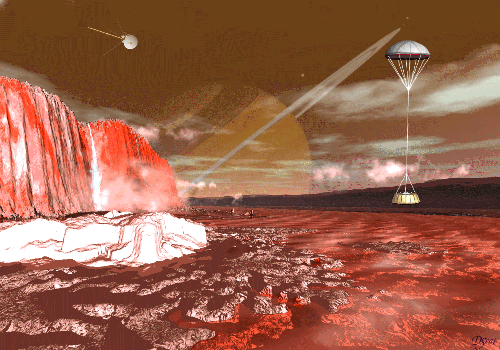 Artist's Concept of Huygens Probe Landing On Titan
Artist's Concept of Huygens Probe Landing On Titan
E. Pluto and the Kuiper Belt
Pluto is entirely unlike the four large outer planets. With a diameter of only 1475 miles, it is smaller by a factor of 2 than any of the terrestrial or Jovian planets. It is a rocky/icy object rather than a gas giant. Its orbit is the most highly inclined to the ecliptic plane of any of the classical "9 planets."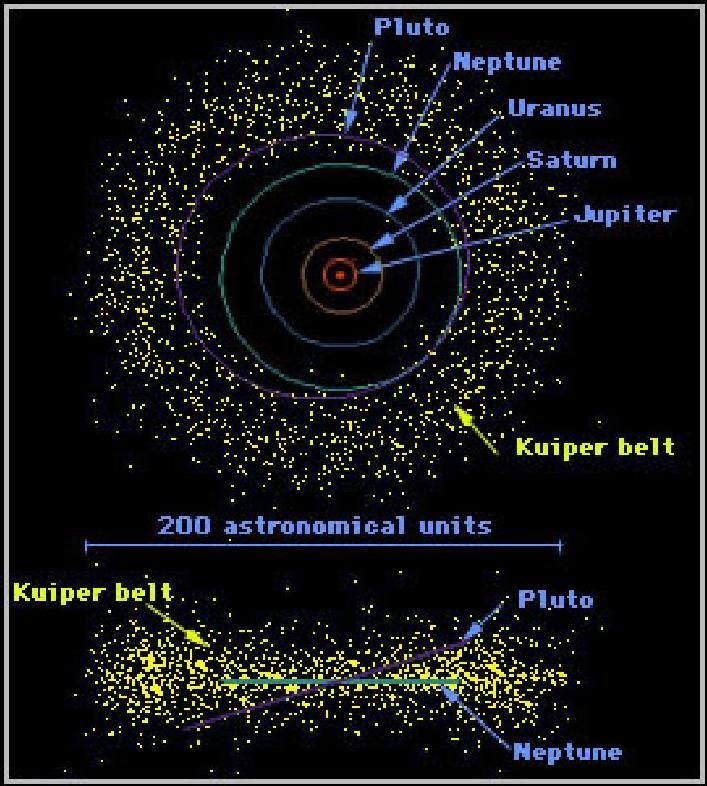 When first discovered, Pluto was thought to be
isolated at the edge of the Solar System. However, in the last 25
years, after wide-field digital detectors were installed on large
telescopes, astronomers have identified many more similar
bodies, some with sizes comparable to Pluto. These, including Pluto,
are all members of
the "Kuiper
Belt".
When first discovered, Pluto was thought to be
isolated at the edge of the Solar System. However, in the last 25
years, after wide-field digital detectors were installed on large
telescopes, astronomers have identified many more similar
bodies, some with sizes comparable to Pluto. These, including Pluto,
are all members of
the "Kuiper
Belt".
- The Kuiper Belt is a huge volume beyond the orbit of Neptune, centered on the ecliptic plane, but extending many AU's above and below the plane. It is much larger than the asteroid belt, which lies between Mars and Jupiter. Over 1000 "Kuiper Belt Objects" (KBO's) have been discovered in this volume to date. A number of these are larger than any of the asteroids; Pluto, for instance, is 2.5 times the diameter of Ceres, the largest asteroid. Here is a comparison of the eight largest KBO's and their satellites to one another. The plot at the right shows the known KBOs with the Belt both face-on and edge-on (click for an enlargement).
- The most massive known KBO---yes, it's more massive than Pluto---is Eris, also the second most distant known KBO (97 AU). It was discovered in 2005. Its size (1400 miles diameter) is slightly smaller than Pluto's. Click here for a page describing Eris by its discoverer, Mike Brown.
- Sedna, a 600-mile diameter object discovered in 2003, has an aphelion (greatest orbital distance from the Sun) of 937 AU, although at present it is at only 90 AU. Its orbital period is about 11,400 years. It is distant enough that it may be a member of the "Oort Cloud" rather than the Kuiper Belt. The object 2012 VP113 is similar to Sedna, with a perihelion (minimum orbital distance from the Sun) of 80 AU, currently the most distant perihelion of any Solar System body. Some of the known KBO orbits are shown individually here.
The Pluto Flyby
New Horizons, the first mission to Pluto and the Kuiper Belt, was launched by NASA in 2006 and, having received a gravity assist from Jupiter, finally reached Pluto on 14 July 2015. (Yes, nine years later. The fact that New Horizons was launched with the brisk velocity of over 36,000 miles per hour gives you some appreciation for the scale of the solar system.) The spacecraft could not carry enough fuel to decelerate into orbit around Pluto (that would have made it much more massive and expensive), so it was always planned as a "flyby," with a closest approach of about 7800 miles. It took over 15 months for all the data collected during the brief flyby to be telemetered back to Earth.-
New Horizons returned a wealth of data on the surface and atmosphere
of Pluto and the nature of its 5 satellites. Although
the strangeness of Pluto's surface was anticipated by the 1989
Voyager images of Neptune's moon Triton, the close-range, high
resolution imaging of New Horizons revealed amazing features.
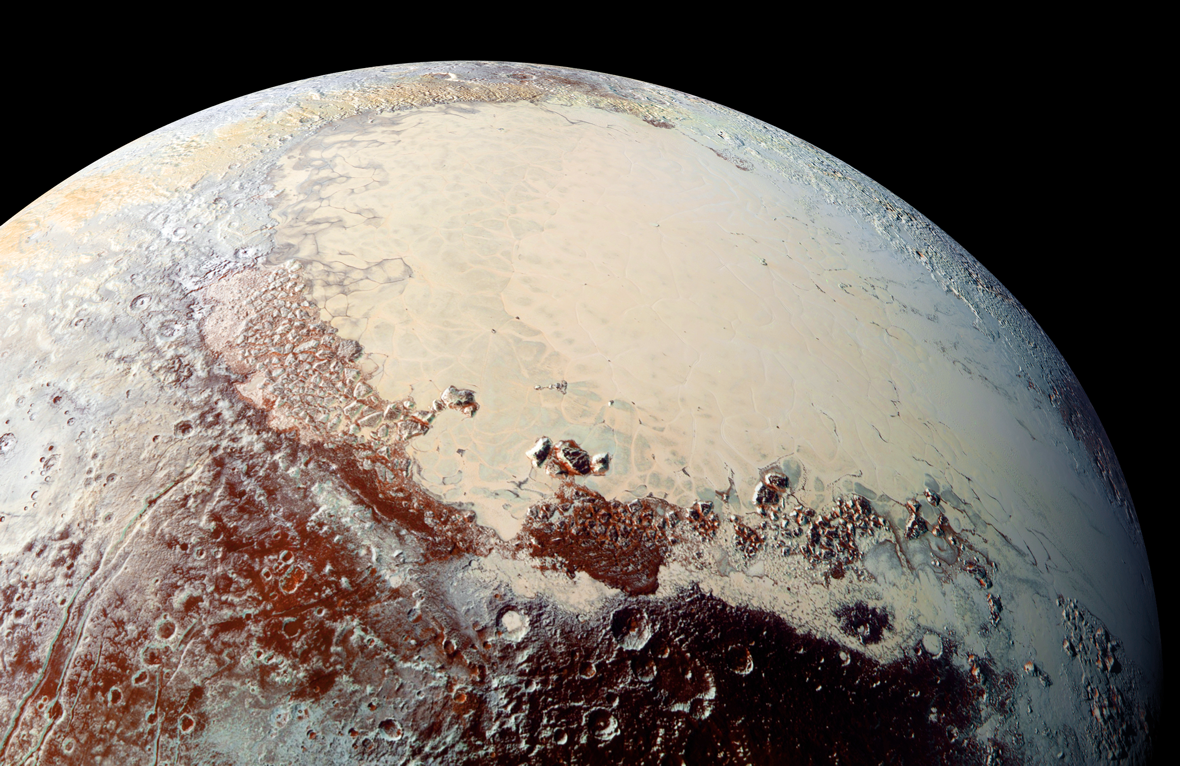
-
Much of the surface is covered by rugged terrain (reddish-brown in the
image above), with mountains ranging up to 16000 feet high. The
surface is not made of rock, however --- rather of a mixture of ices
of nitrogen, water vapor, carbon monoxide, and methane, which have
frozen out at the very low temperature of Pluto (-230C). The
cratering density in the mountainous regions indicates ages up to 4
billion years old.
The smooth, light-colored regions in the image above (part of the
heart-shaped "Tombaugh Regio") almost entirely lack cratering and are
therefore much younger, less than 10 million years old. They consist
mainly of frozen nitrogen and carbon monoxide. The surface is broken
into polygonal cells (see image below right), which indicate
relatively recent convective motions.
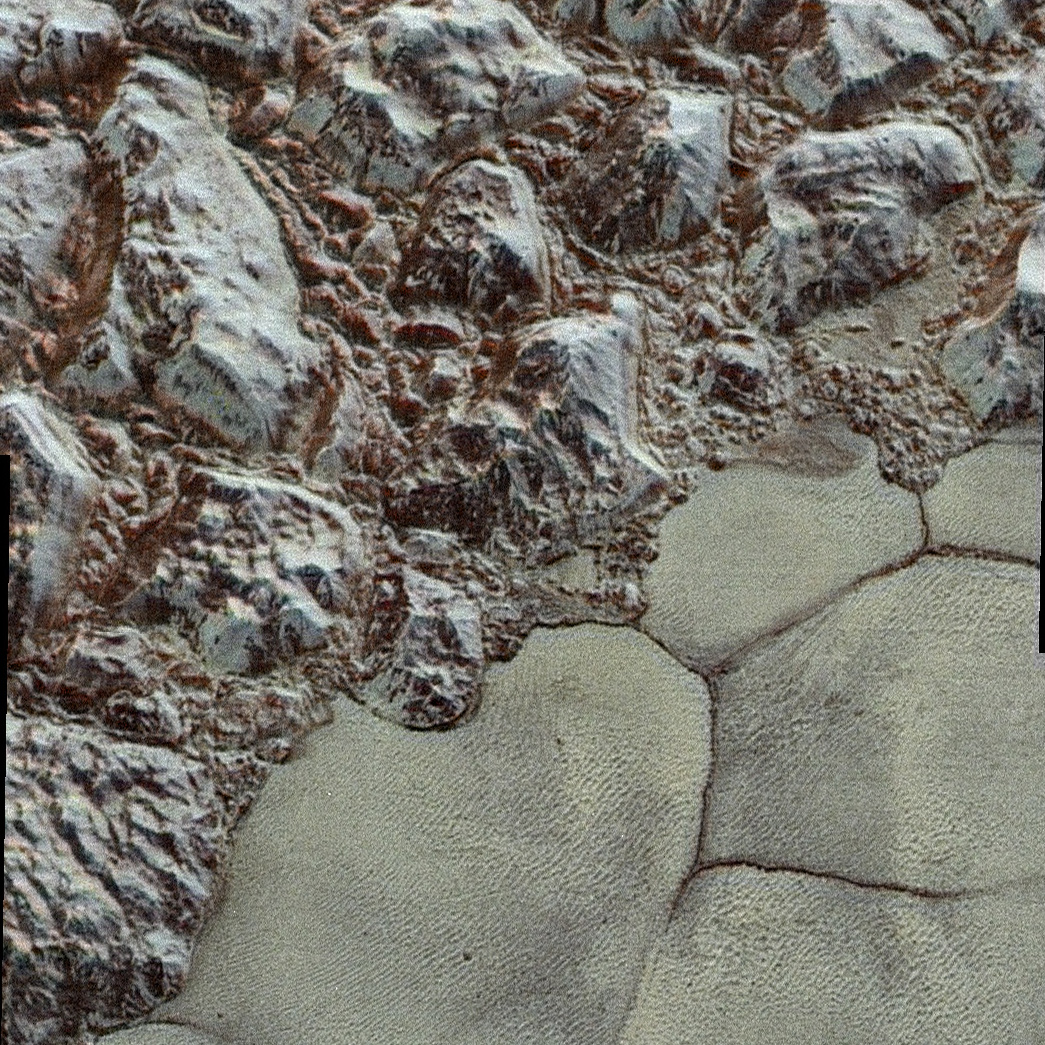 The force of the rising
ice was apparently enough to float the mountains of water ice lying at
the margins of the region.
Overall, Pluto is revealed as much more geologically active than
expected, with exchanges continuing to occur between the surface and
interior (including through apparent "cryovolcanos") and between the
surface and the atmosphere. The thin
atmosphere, consisting
mainly of nitrogen, methane, and carbon monoxide, partially freezes
out on the surface and then sublimes as Pluto's distance from
the Sun changes.
Charon, the largest (750 miles
diameter) of the five satellites of Pluto, also features surprisingly
complex terrain, with rugged canyons --- in this case almost
exclusively formed of water ice and without much change in the last 4
billion years.
The force of the rising
ice was apparently enough to float the mountains of water ice lying at
the margins of the region.
Overall, Pluto is revealed as much more geologically active than
expected, with exchanges continuing to occur between the surface and
interior (including through apparent "cryovolcanos") and between the
surface and the atmosphere. The thin
atmosphere, consisting
mainly of nitrogen, methane, and carbon monoxide, partially freezes
out on the surface and then sublimes as Pluto's distance from
the Sun changes.
Charon, the largest (750 miles
diameter) of the five satellites of Pluto, also features surprisingly
complex terrain, with rugged canyons --- in this case almost
exclusively formed of water ice and without much change in the last 4
billion years.
The Arrokoth Flyby
Following the Pluto encounter, New Horizons was retargeted to fly by another KBO, 2014 MU69M, which was located in a special 2014 search for objects near to the spacecraft's outgoing trajectory. New Horizons performed a highly successful flyby of this second KBO, now officially named "Arrokoth," on 1 January 2019. Data taken will be streaming back to Earth through mid-2020. But it was immediately clear that Arrokoth is a fascinating object. It is a binary, with two lobes joined at a narrow neck; the largest lobe is about 22km across. Both lobes are significantly flattened. The reddish color (also conspicuous on Pluto and Charon) is caused by tholins, organic compounds produced by solar UV irradiation of carbon-based materials like methane and carbon dioxide.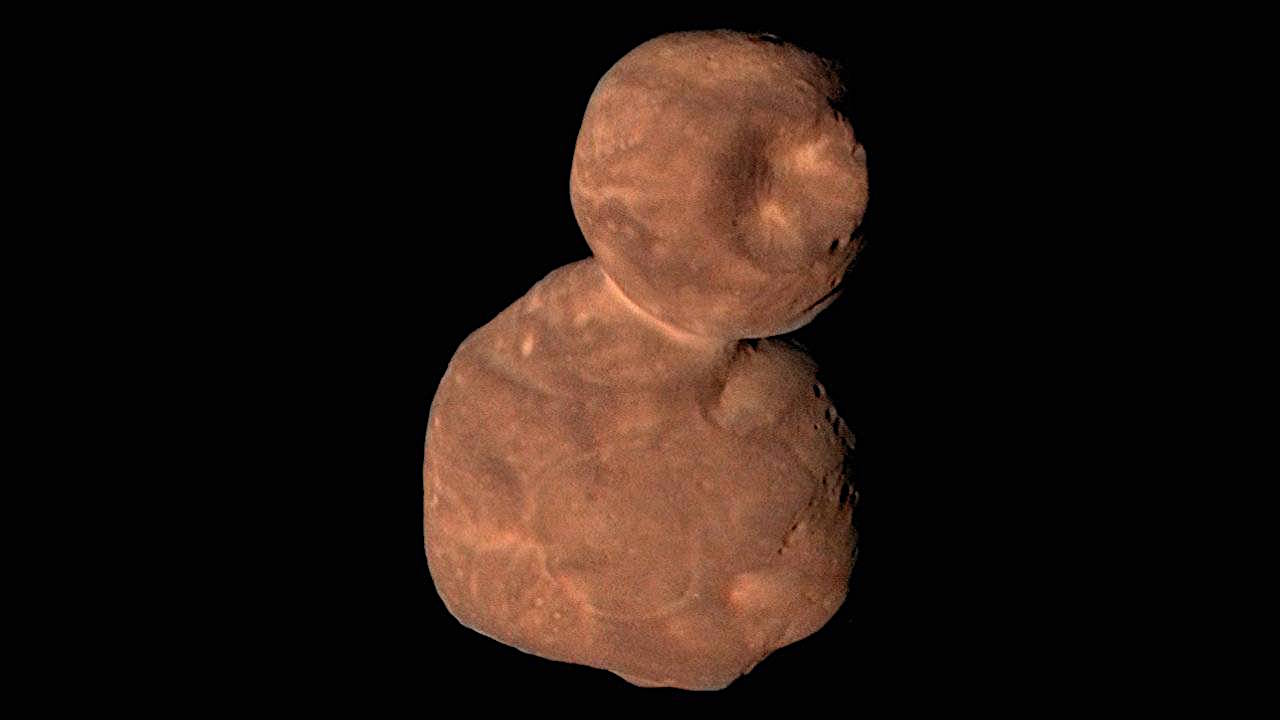 Arrokoth as imaged by New Horizons
Arrokoth as imaged by New Horizons
Reading (this material covers 2 lectures):
-
Study Guide 20
Bennett textbook, Chapter 11
-
Study Guide 21
Bennett textbook, Chapter 12
Web Links:
-
The Race
for Neptune (MacTutor)
Happy first birthday, Neptune! (2011 marked the end of the first Neptunian year, which is
165 Earth years, since it was discovered; see this congratulatory note from Phil Plait) JPL Photojournal Image Site
Information & Images at Views of the Solar System
Selected Images of Europa (O'Connell) The Voyager Missions
-
Voyager Gee-Whiz Stuff
Voyager Grand Tour Videos
Current locations of Voyager and Pioneer spacecraft
The Cassini-Huygens Mission to Saturn and Titan
Interactive Global Maps of Jupiter and Galilean Satellites (New York Times) The New Horizons Mission to Pluto and beyond International Astronomical Union explanation of planet types
Songs---yes, songs---about the demise of Pluto
Interview with the "Man Who Killed Pluto" (NPR, "On Point")
 Previous Guide
Previous Guide
|
 Guide Index
Guide Index
|
 Next Guide
Next Guide
|